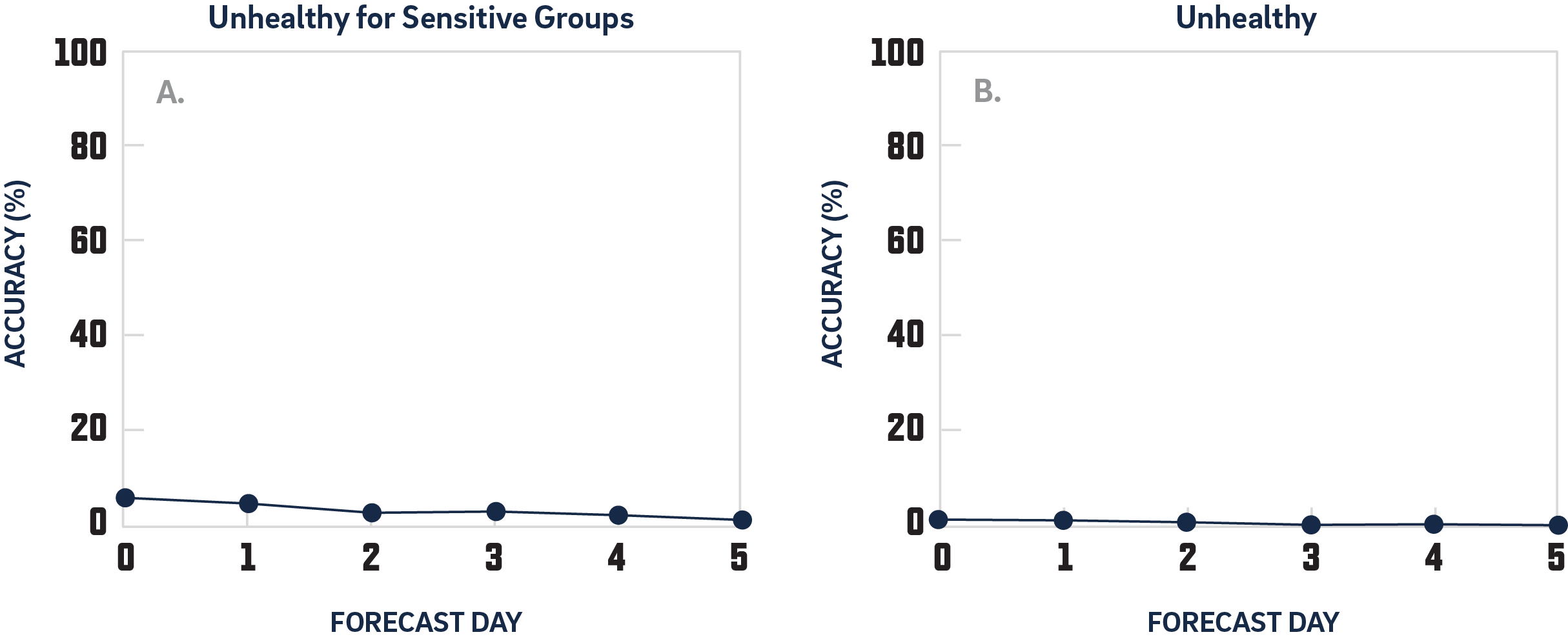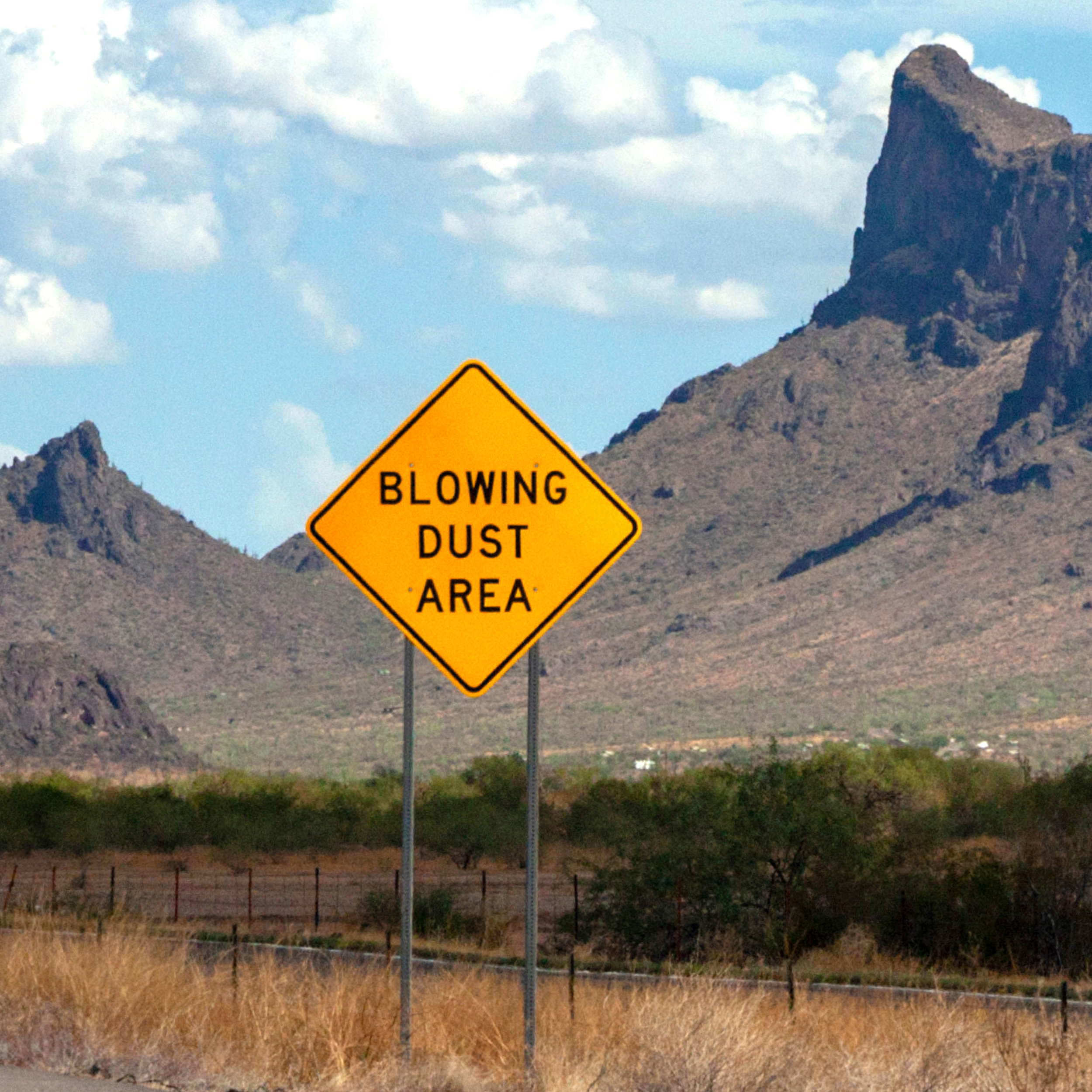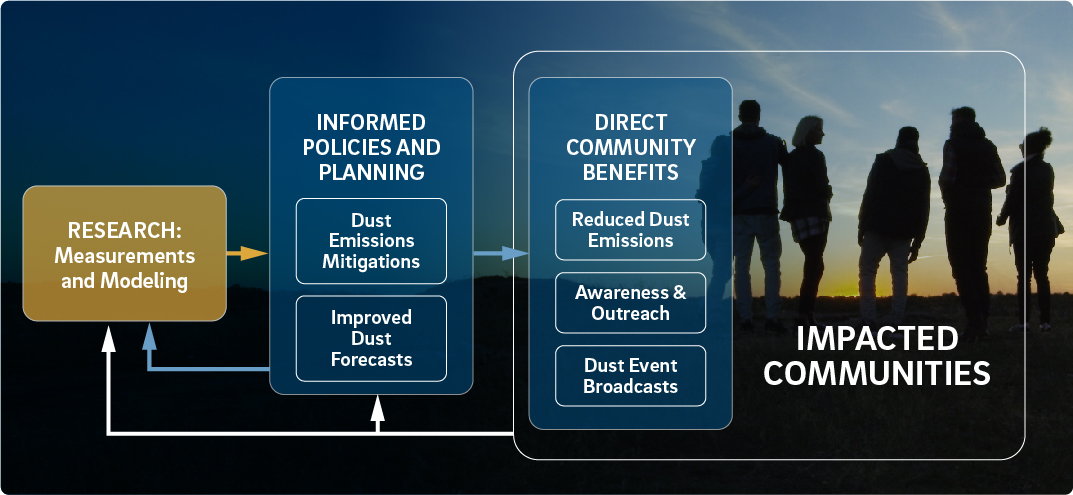
As previously discussed, dust storms are associated with a myriad of negative health, environmental, and economic impacts. Reducing emission of–and exposure to–windblown dust represents a unique challenge, since emissions tend to be less consistent, predictable, and controllable than other common sources of atmospheric particulates. In part as a result of these challenges, windblown dust emissions in California have increased over time, even as other anthropogenic particulates have seen reductions over the years. Thus, developing effective strategies to minimize the negative impacts of dust in California, including adaptation and mitigation, is imperative. Here we present strategies that have proven to be useful in other locations, and discuss implementation challenges.
Dust Source Mitigation
In cases where the sources of dust are anthropogenic in nature direct mitigation is an effective approach to minimize dust emission. As previously described, windblown dust emissions are typically tied to strong surface winds over dry, erodible surfaces. Dust source mitigation strategies generally aim to increase surface roughness over target areas, therefore slowing surface winds and reducing the likelihood of dust particle suspension, or modifying surface properties such as soil moisture to reduce emissions. There is a large body of literature on mitigation techniques designed to minimize erosion in croplands and pasturelands in arid regions, as well as dune stabilization, which include short term strategies like preserving crop residues, and longer-term strategies like planting windbreaks. Dust source mitigation also requires continuous landscape management to minimize disturbances to the surface like from off-highway vehicle use, which can render efforts ineffective and cause irreversible damage to the environment.
One example of anthropogenic dust source mitigation is the Owens Lake, which lies just east of the Sierras and was desiccated due to a water diversion project that was constructed in the early 20th Century. Over the last 25 years billions of US dollars have been spent implementing a variety of dust emission control measures on the now dry lakebed, including surface roughening, controlled flooding, and vegetation enhancement, although the effectiveness of each specific measure is still not completely understood . Another example of an anthropogenic dust source is the Salton Sea, which is a large lake in the southeastern corner of the state that is rapidly drying due to water diversion. Dust source management activities, similar to those implemented at Owens lake, are currently being tested on the exposed playa there. The long term efficacy of these management techniques is not easy to assess, since environmental changes like drought may render some techniques ineffective or unfeasible. Furthermore, evaluating the effectiveness of this work in terms of minimizing the adverse impacts of dust will always be somewhat uncertain since characterizing dust emission from natural sources in the surrounding areas is difficult.
Dust source mitigation is an expensive technique that requires continued investment in application and monitoring that is limited to discrete anthropogenic sources of dust. While minimizing any wind-blown erosion should improve air quality, the exact benefits to human health are difficult to quantify.
Dust impacts mitigation: forecasting improvements
While efforts to mitigate dust emissions sources can be helpful for scenarios where emissions are predominantly coming from known, consistent, and spatially limited sources (e.g. unpaved roadways or active construction sites), such work is generally only applied to a small subset of dust events. For most dust storms, robust and reliable forecasting and communication tools can help to minimize impacts, and have been a focus of air pollution research and policy in dust-impacted areas around the world. Although PM10 forecast products for various regions of the state exist, their usefulness is limited. For example, five day forecasts of air quality from PM10 for the Imperial Valley, a region frequently impacted by dust storms, are available via the Imperial County Air Pollution Control District. Preliminary work conducted by the report authors has identified three main shortcomings of this forecast: 1) the forecast only provides a daily average PM10 air quality index (e.g., healthy, unhealthy, extremely unhealthy, etc.) but does not indicate how poor the air quality will be at a given time or the duration of the unhealthy air quality, 2) the forecast shows little skill in actually forecasting unhealthy air quality, and 3) as a result, informal polling of community members in the Imperial Valley indicates that this forecast product is not used by the people most impacted by dust. We note that nearly identical results were obtained when repeating this analysis for PM10 forecasts generated for the Coachella Valley, an area also impacted by dust. Providing accurate, high spatiotemporal resolution dust forecasts to impacted communities is an urgent task; a trustworthy forecast can generate community confidence, adoption, and thus actionable information.

Previous modeling work has shown that uncertainties related to surface properties associated with dust emissions are likely a major contributor to overall model error, making development and evaluation models that correctly reflect the relation between surface properties and dust emissions a high priority for dust forecast improvement. Integrated surface measurements and remote sensing data products have been used previously to identify especially emissive locations, or hotspots, allowing for improved dust event intervention strategies . Using the same approach, dust emissive hotspots in California could be identified. Around California’s Salton Sea region, an area of increasing concern for windblown dust levels due to a shrinking lake footprint, measurement efforts have also included direct surface observations of emissivities, providing valuable data on surface properties themselves and the relationship between wind speeds and resulting dust emissions. These long-term local measurements and focused field campaigns are important steps towards understanding regional dust emissions and identifying areas where further data is needed to answer key air quality questions related to dust emissions and transport. However, since soil surface properties and related dust emissions are highly variable in space, it is necessary to expand the coverage of dust measurements, including into agricultural lands. Furthermore, ongoing assessments of surface conditions and evaluation of forecast model performance are needed since the environmental conditions that give rise to dust storms are dynamic. Coupled comprehensive modeling and measurement efforts are necessary to identify not only how robust and representative current surface property datasets and emissions inventories may be, but also how to continue to improve them.
Robust and effective forecast products are a proven method to mitigate the adverse health impacts of dust. The following three tasks are identified as critical to generate actionable dust forecasting in California: 1) create accurate surface properties for forecast model input datasets, 2) initiate an ongoing effort to measure dust emission across different land use types, such as playas and croplands, to better parameterize dust emissions mechanisms used to produce modeled forecasts, and 3) expand efforts to monitor PM10 across the state so that forecast models can be continually tested and improved.

Dust impacts mitigation: early warning of dust events
With windblown dust source regions often distributed over large areas of remote, unmanaged land, reducing the negative impacts of dust events should also include real-time forecasting of significant events when they occur. Timely communications with affected communities plays a crucial role in reducing dust exposure and is considered part of the success of real-time dust forecasts. For example, between 2007 and 2011, 72% of all vision-obscured fatal crashes occurred when no visibility advisory was in effect. For real-time warning of dust events a separate but related modeling strategy must be developed that can produce forecasts on time scales of minutes. Furthermore, developing an application for mobile devices that allows for communication of immediate risks, and for the public to report and monitor dust events based on their locations, is a reasonable strategy to mitigate adverse impacts of dust storms in affected communities.
There is a need to generate an early warning system for dust storms in impacted parts of the state to provide timely and actionable information on significant dust events as they occur.
Awareness of dust impacts and outreach
Efforts to raise awareness about dust-related health concerns in California face several challenges, including limited and inconsistent funding, difficulties in reaching rural communities, and the complexities of engaging with diverse populations across the state. Language and cultural barriers, along with distrust of researchers and Western medicine, further hinder outreach. To address these issues, it is essential to promote and facilitate research on climate and health disparities that specifically target rural and vulnerable communities . Vulnerable populations—including immigrants, undocumented individuals, and those of low socioeconomic status—are especially difficult to reach for both data collection on dust exposure and the distribution of health information.
High dust exposure, a major factor exacerbating the health of rural communities, is not typically included in the health and risk assessments at the state level. The regions of California most affected by dust storms also tend to house the most vulnerable populations, making it crucial to tackle long-standing environmental inequalities in these underserved areas. Achieving success by reducing airborne dust and dust-related health impairments will require collaboration between affected communities, researchers and policy makers, particularly in the San Joaquin, Imperial and Coachella Valleys. These communities are acutely aware of the risks they face and possess valuable local expertise that can enhance efforts to mitigate dust exposure.
A comprehensive strategy encompassing awareness, prevention, and restoration is needed to address the challenges posed by dust in recreational areas. Adopting land management practices that can reduce dust emissions is a crucial step toward mitigating the impact of anthropogenic dust emissions on both human health and the environment, else outdoor recreational activities may witness a “silent spring”, one without the “beauty of bird songs”. Bridging the gap between local concerns and the goals of scientific and policy efforts is key to creating effective, sustainable solutions.
There is a need to involve community groups in both research and outreach initiatives to both empower impacted communities and ensure the development of culturally relevant strategies for promoting awareness and change.
Budget gaps
Dust storms are pervasive in California, yet despite the large amount of funding for mitigation of a small number of dust sources in the state, there is little investment in developing capacity for dust impacts mitigation. As such, it is not possible to accurately predict when, where, and for how long dust levels become unhealthy or unsafe. California has the opportunity to become a leader in dust impacts mitigation, opening up opportunities for collaboration between legislators, state agencies, scientists, and community groups on this important issue. From this foundation, there are significant opportunities to expand these collaborations to other dust-prone regions of the country. Given the numerous adverse health impacts of dust storms and risk to transportation safety by impairing visibility on highways, efforts focused on tracking and forecasting tied to hospitalization data will generate the capacity to improve the health of the people who live and work in the dustiest regions of California. This work will also help to address long-standing environmental inequalities for these historically underserved communities. The dust-related challenges highlighted here and in prior chapters demonstrate identifiable gaps and areas of need. The collection of data will be necessary to address these gaps.
A long-term commitment to sustainable funding for research and application solutions is required to improve air quality, health, and public safety in communities that are impacted by dust.

Summary
Dust has significant impacts on human safety and health. As dust emissions in California have increased in the past and likely will continue to grow in the future, developing effective adaptation and mitigation strategies to minimize dust impacts needs to be prioritized. Furthermore, the locations in the state with some of the highest concentrations of dust in the air are also home to some of the most vulnerable and underserved populations here. The figure summarizes different strategies and actions to reduce the various negative impacts of airborne dust, including increasing public awareness of dust’s effects on human safety and health through outreach, providing accurate and high spatiotemporal dust events forecasts, broadcasting dust events to impacted communities in real-time, and targeted dust emission mitigation work. Research and measurements are the foundations of these strategies and actions, as the rest are extended from these two components. Therefore, they are the backbones of the reduction of negative dust impacts. However, the feedback and interactions between these strategies and actions are critical to the success of these dust adaptation and mitigation strategies. The challenges of awareness stem from inadequate and inconsistent funding, difficulties in reaching rural communities, and the complexities of engaging with diverse populations across the state.
To carry out critical mitigation strategies three equally important activities must be taken: 1) generation of key environmental measurements and development of forecasting capacity, 2) an integrated effort between the communities, researchers, and state agencies, and 3) consistent and sustainable funding support.


